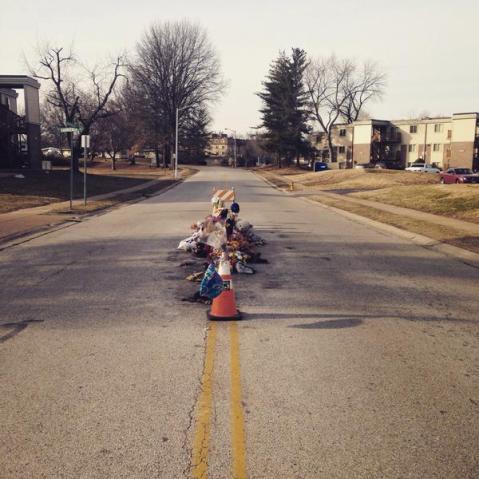NEWS
January 22, 2015

IN BRIEF
By: Nora Rahimian. When Darren Wilson, the officer who shot and killed 18-year-old, unarmed, Mike Brown in Ferguson, Missouri was not indicted (indict: formally accuse of or charge with a serious crime; not try in a courtroom with jurors, but simply accuse), people got angry. Despite eyewitness testimonies that said Brown was not acting aggressively and had his hands up when he was shot, the case ultimately became a s/he said-s/he said of the police versus the people.Without physical proof of Wilson’s aggressive attack (or Brown’s peaceful compliance, depending on which narrative you support), the state ultimately sided with itself [...]
SHARE
When Darren Wilson, the officer who shot and killed 18-year-old, unarmed, Mike Brown in Ferguson, Missouri was not indicted (indict: formally accuse of or charge with a serious crime; not try in a courtroom with jurors, but simply accuse), people got angry. Despite eyewitness testimonies that said Brown was not acting aggressively and had his hands up when he was shot, the case ultimately became a s/he said-s/he said of the police versus the people.Without physical proof of Wilson’s aggressive attack (or Brown’s peaceful compliance, depending on which narrative you support), the state ultimately sided with itself and let Wilson go.
Protests erupted around the United States as people mourned the lack of justice, with solidarity protests popping up in the UK, India, and other countries around the world. As activists called for systemic change, many people argued that if “it’d only been caught on tape”, they would have been able to hold Wilson accountable.
Following these outcries, President Obama asked for funding for 50,000 body cameras to record police interactions in a plan that also included more training for police. The thinking was that if incidents are recorded, then there can be no question of responsibility when incidents arise between the people and the police.
Less than a week and a half after Wilson’s non-indictment, and only days after Obama’s announcement, a separate grand jury- this time in New York- decided not to indict another officer for the murder of another unarmed Black man. Daniel Pantaleo was caught on tape- not by body cameras but by bystanders with cell phones and access to social media- choking 43-year-old Eric Garner to death. Garner, an asthmatic who had reported being harassed by Pantaleo previously, can be heard on the video repeating, “I can’t breathe. I can’t breathe.”
People were outraged. Here at the very least, was the video proof that should have been enough to allow Pantaleo to stand trial and accept some degree of responsibility . But despite this- and the ruling by the state’s medical examiner that Garner’s death was, in fact, a homicide- there was no justice or accountability. Pantaleo won’t stand trial.
Brown and Garner are only two examples of cases where there has been a clear breakdown of accountability within the systems that are supposed to ensure justice. Without accountability, the impression is that the state allows its officers to act with impunity. And that, right there, is really the problem. While body cameras might allow us to say, “S/he did that,” they don’t ensure accountability. Accountability starts with acknowledgment of harm and acceptance of responsibility for wrong-doing. It necessitates responsiveness from the authorities, who should be able to provide answers and information quickly and transparently. It involves enforceability, where there are appropriate (and ideally restorative) consequences. And it contains answerability, where beyond these specific cases, the necessary systemic changes are made to prevent this kind of harm from happening again.
In both the Wilson and Pantaleo cases, all four of these pillars of accountability- responsibility, responsiveness, enforceability, and answerability- have been absent. In fact, following Brown’s murder on August 9, 2014 more than 40 other Black people have died from police violence including 12-year-old Tamir Rice, mother-of-3 Aura Rosser, and mentally-challenged Ezell Ford. The fact that the killings appear to be increasing in frequency despite the increased scrutiny on police actions only serves to reinforce the perception that law enforcement is acting without regard for justice. Until the public sees something to the contrary- concrete actions that acknowledge the hurt inflicted on Black communities, that have real consequences, and that fix the flaws in the system that enabled these injustices in the first place- communities will continue to protest and resist.
Nora Rahimian is a code-switcher and community-builder who uses entertainment and the arts as tools for peacebuilding and social justice. She has led workshops and projects throughout the U.S. and Central America, working with youth and in communities highly affected by violence. She lived in Liberia for the last three years, developing alternative-education programs for higher-risk and out-of-school youth, supporting musicians as they created infrastructure for the country’s budding post-war music industry, and establishing The Hip Co Festival. She founded the Hip Co Accountability Network to engage popular artists as anti-corruption and accountability ambassadors and manages Anti-Rape Ambassador and Hip Co Artist of the Year, Takun J. In 2014, she co-founded #CultureFix, a global collaborative network of artists and change makers who uses arts ad culture to create social change in communities around the world. Find her on Twitter and Instagram at @norarahimian.

